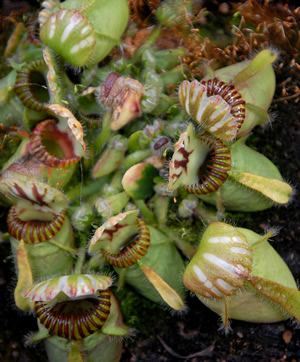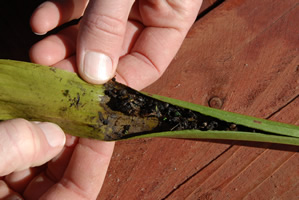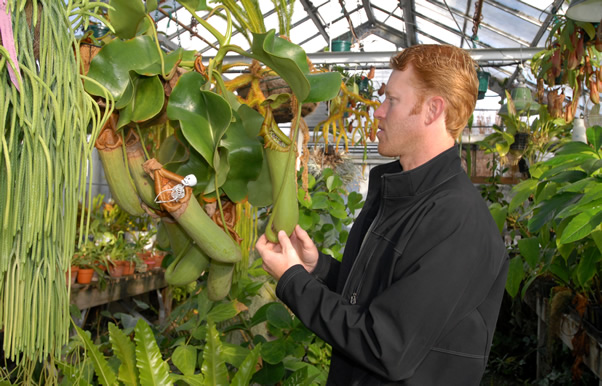Violent Feeding Habits
Hundreds of Carnivorous Plants Thrive in CSUF’s Greenhouse
February 24, 2009
By Russ L. Hudson
Hardy and violent, they can thrive in standing water, bogs, poor soil, full scorching sun and frost, where they attract, trap, dissolve and digest their prey while it lives.

A batch of Cephalotus follicularis, an Australian Pitcher Plant, is one of the more exotic “pitchers” in the greenhouse. Photo by Kelly Lacefield
Carnivorous plants. Hundreds of them fill the Cal State Fullerton Biological Science Greenhouse, which shares them with greenhouses across the country.
But they suffer from severe vulnerabilities. Venus flytraps, for example, can survive weeks without a fly, but can’t tolerate the alkaline solids dissolved in tap water. Other carnivorous plants die when placed too close to a heater or air-conditioning vent, or if left unprotected in a sustained Santa Ana wind.
“Flytraps and other carnivorous plants need special care. Not difficult, but special,” explains Ed Read, manager and instructional support technician of the university greenhouse and a carnivorous-plant aficionado. He teases a flytrap with two feather-soft touches to make it snap shut. “Most people don’t know that. Especially about the tap water. They can live indoors if you feed them, but they need pure water, whether it’s distilled, reverse-osmosis, even rainwater.” Flytraps, Read points out, evolved in swamps in the Carolinas where it is humid, the water is pure and the hot sun shines fully on them.
Read watches over hundreds of flytraps, and those are aren’t the only carnivores under the greenhouse glass.

Half-digested insects are found in the opened stem of a Sarracinea. Photo by Kelly Lacefield
Read cares for such cultivars as the sticky-leaved Pinguicula X Titan, a butterwort hybrid developed in the 1980s at Cal State Fullerton and named after the university's mascot; Dionaea X Jaws, a species of flytrap with reddish coloring and shark-like “teeth” around the edges of its maw that was developed in the greenhouse in the 1990s; pitcher plants that lure prey with sweet nectar then, with waxy surfaces below the nectar, slide the hapless victims down the sides of the pitcher-shaped bases into pools of digestive juices; and lightning-fast bladderworts, with traps on their roots that suck in prey in less than one fifteen-thousandths of a second.
“Our carnivorous plant collection is a favorite topic of the facilities tour I give the Evolution and Biodiversity Class students each semester. By the looks on their faces, I can tell that many are uninterested in plants. But, when I cut open the tubular leaf of a Sarracenia and partially digested bugs pour out, their faces light up and their minds open. Carnivorous plants are really bizarre. There are several trapping mechanisms and each is unique,” Read said.
Sundews — Drosera — for example, have yet another method to catch their prey: sticky, almost hair-like appendages on their leaves or stems that trap and digest bugs.
The greenhouse's carnivores are in high demand, says Read. “We supply specimens to other universities and organizations, a common practice in this field. I recently supplied several dozen leaf samples to a researcher at UC Berkeley doing taxonomical work using DNA to study the genus Drosera. We had many plants that she needed to complete her wish list.”
Read, always enthusiastic about not just the carnivores in the greenhouse but the entire collection, wishes the Biological Science Greenhouse was set up so the public could be accommodated on a walk-in basis. "Right now tours and visits have to be scheduled ahead of time, by prior arrangement."
“It is my hope, though,” Read says wistfully, “that some day we can have a conservatory added to the greenhouse complex that will be open for passersby to walk in and enjoy. We have many plants with interesting stories."
The Biological Science Greenhouse provides space and facilities to teach labs and conduct research. It also houses a diverse collection of plants for use in the biology lectures and labs. Hundreds of students pass through the greenhouses each semester as they learn about plants and biodiversity.
For information or to schedule tours, contact Read at 657-278-2766 or eread@fullerton.edu.


